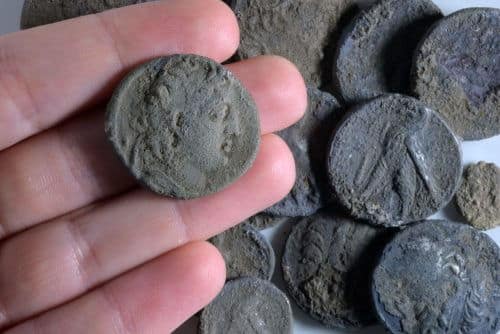Unearthed in an excavation by the Antiquities Authority, next to the wall of an agricultural estate * Director of the excavation, Avraham Tendler: "It seems that the treasure belonged to a Jew who hid his money in the hope of returning and collecting it, but it seems that his luck did not favor him and he never came back."

The excavation - before the establishment of a new neighborhood initiated by the municipality of Modi'in-Maccabim-Reot
A hoard of silver coins from the Hasmonean period (126 BC) was uncovered in April in an archaeological dig with the participation of youth conducted by the Antiquities Authority prior to the establishment of a new neighborhood near Modi'in, initiated by the Municipality of Modi'in-Maccabim-Reot. The treasure was hidden in a rock crevice, next to the wall of an impressive agricultural estate that was discovered during the excavation at the site.
According to Avraham Tendler, the director of the excavation on behalf of the Antiquities Authority, "it is a hoard of rare silver coins from the end of the Hellenistic period, including shekels and half-shekels (tetradrachms and didrachms), which were minted in the city of Tyre, and which bear the image of King Antiochus VII and his brother Demetrius II. The treasure we found is fascinating evidence that one of the members of the estate, who saved his income for months, and had to leave the house for an unknown reason, deposited his money in the hope of returning and collecting it, but it seems that his luck did not favor him and he did not return. It's exciting to think that the hoard of coins waited here for 7 years until we uncovered it."

Minister of Culture and Sports MK Miri Regev congratulated on the important discovery. According to her, "The XNUMX-year-old treasure and estate give us, once again, direct archaeological evidence of continuous Jewish settlement for hundreds of years in the Jerusalem and Judea area. This is another moving testimony to the connection of the Jewish people to their country and homeland."
According to Dr. Donald Zvi Ariel, Head of the Mint Branch at the Antiquities Authority, "the hoard, which includes 16 coins in total, contains one or two coins from each year between 135-126 BC, and a total of 9 consecutive years are represented in it . It seems that some thought was put into collecting the coins, and it is not impossible that the person who buried the treasure was a coin collector; He acted just as stampers and coin collectors manage collections today."
According to Avraham Tendler, "From the findings of our excavation, it appears that during the Hasmonean period, a wealthy Jewish family established an agricultural estate on this hill. The family members planted olive trees and vines on the nearby hills, and they grew grain in the valleys.
Next to the mansion, an industrial area of the mansion is being uncovered by excavation, with a textile mill that was used to produce olive oil and warehouses for storing the oil. In the agricultural plots adjacent to the estate, dozens of rock-hewn ghats have been uncovered, which teach about the cultivation of vines and the wine industry in the area. The manor house was built with strong walls, to provide security against conquest campaigns and bandits."
In the excavation, many bronze coins minted by the Hasmonean rulers were found, with the names of one of the rulers on them, such as Yohanan, Yehuda, Yonatan or Mattathias and the description: high priest and head of the Jewish community. The findings indicate that the estate continued to operate
Throughout the early Roman period. The Jewish residents of the estate were strict about the laws of impurity and purity: they installed purification vessels in their settlement and used Kirton stone tools, which according to the Halacha, do not accept impurity.
The excavation found a hint that the residents of the mansion also participated in the first revolt against the Romans, which broke out in 66 AD: on coins from this period that were discovered in the mansion, the date "Year Two" of the revolt is indicated, as well as the slogan "Freedom of Zion".
The estate continued to operate even after the destruction of the Temple, in 70 AD. "It seems that the local residents did not give up hope for independence from Rome, and they prepared well for fighting as part of the Bar Kochba rebellion," says Tendler. "During the excavation of the mansion, we saw how, in preparation for the rebellion, the residents of the mansion filled the row of living rooms adjacent to the outer wall of the building with large stones, thus creating a fortified wall. We also discovered hiding systems carved into the rock - under the floors of the mansion. These systems connected water cisterns, storage pits and hiding rooms with the help of burrows. In one of the nearby excavation sites, an impressive purification mikve was revealed; When we dug deeper into the mikveh, we discovered an opening to a branched secret system, in which many finds were found from the time of the Bar Kochba revolt."
The unique finds will be preserved as an archaeological park in the heart of the new future neighborhood of Maccabim-Modi'in-Reot.

One response
Amazing findings, what fun to hear.
The thought of the ancient and continuous history of our people in this place causes awe every time. This is a huge and exciting force.